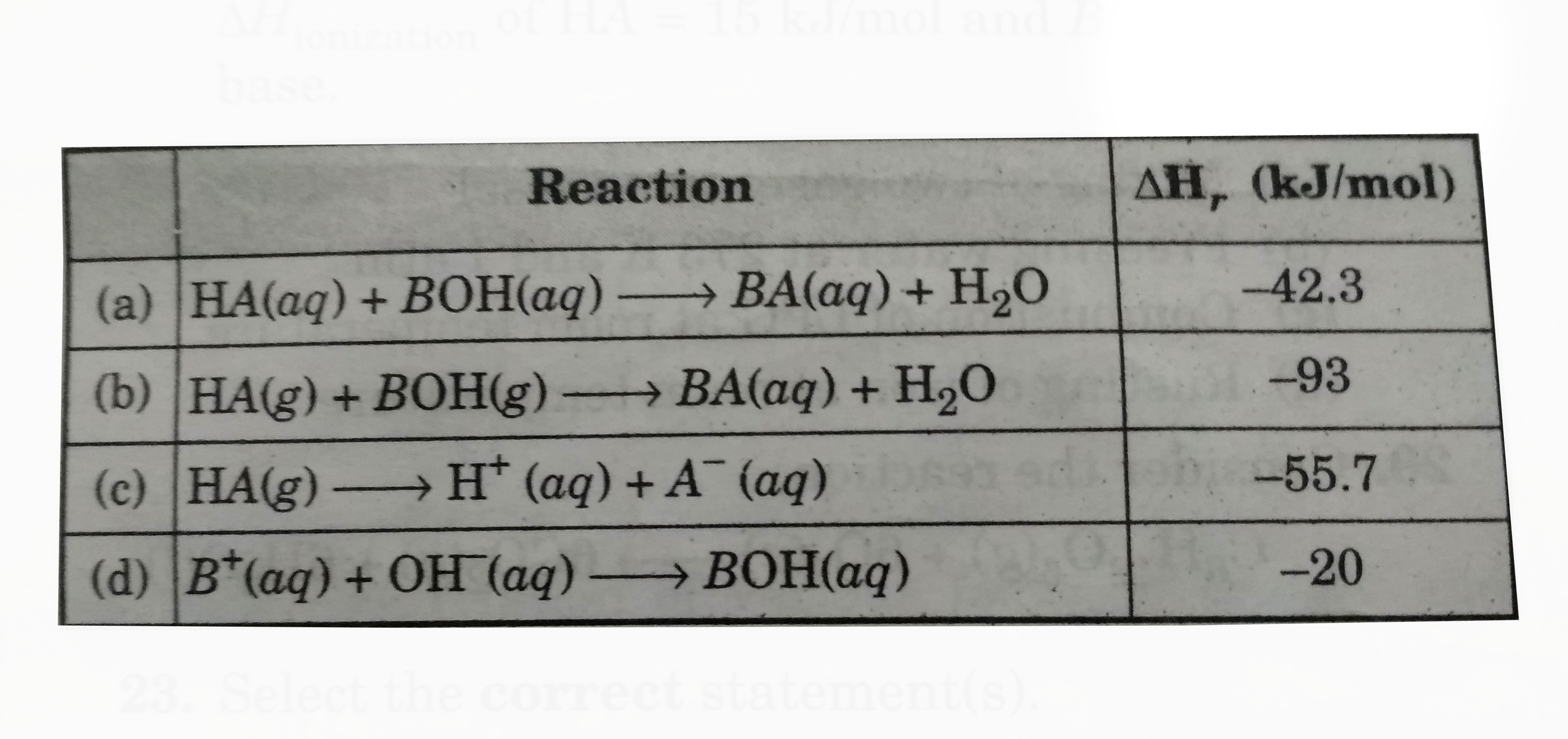From the following date , mark the opation(s) where ΔH is correctly written for the given reaction .
Given: H+(aq)+OH−(aq)→H2O(l), ΔH=−57.3kJ
ΔHsolutionHA(g)=−70.7kJmole
ΔHsolutionBOH(g)=20kJmole
ΔHionzatoin of HA=15kJ/mole and BOH is a strong base.
 Solution in Telugu
Solution in Telugu
Reaction ΔrH(kJ/mol)
HA(aq)+BOH(aq)→BA(aq)+H2O −42.3
Reaction ΔrH(kJ/mol)
HA(g)+BOH(g)→BA(aq)+H2O −93
Reaction ΔrH(kJ/mol)
HA(g)→H+(aq)+A−(aq) −55.7
Reaction ΔrH(kJ/mol)
B+(aq)+OH−(aq)→BOH(aq) −20
The correct Answer is:A, B, C
(a)ΔrH=15+0−57.3=−42.3 kJ
HA(g)+BOH(g)ΔrH−−→BA(aq)+H2O

ΔrH=−70.7+15=−55.7
(d)B+(aq)+OH−(aq)→BOH(aq)
ΔrH=0
Topper's Solved these Questions
- THERMODYNAMICSBOOK - NARENDRA AWASTHICHAPTER - THERMODYNAMICSEXERCISE - Level 1 (Q.1 To Q.30)
6 Videos
- THERMODYNAMICSBOOK - NARENDRA AWASTHICHAPTER - THERMODYNAMICSEXERCISE - Level 1 (Q.31 To Q.60)
2 Videos
- STOICHIOMETRYBOOK - NARENDRA AWASTHICHAPTER - STOICHIOMETRYEXERCISE - Level 3 - Subjective Problems
20 Videos
Similar Questions
A system undergoes a process in which ΔU=+300J while absorbing 400 J of heat energy and undergoing an expansion against 0.5 bar. What is the change in the volume (in L)?
View SolutionA gas expands against a variable pressure given by P=20V (where P in atm and V in L). During expansion from volume of 1 litre to 10 litre, the gas undergoes a change in internal energy of 400 J. How much heat is absorbed by the gas during expansion?
View SolutionWhat volume of a liquid (in L) will contain 10 mole ? If molar mass of liquid is 280 and its density is 1.4 g/mL.
View SolutionCalculate the ethanly change for the given reaction from data provided (KJ/mole) {:(HA(g),+,B(g),to, AHB(s)),(("weak acid"),,("Weak base"),,("Salt")):} DeltaH_("neutralization "){HA(aq)["at infinte dilution "]//B(aq) ["at infinite dilution "]=-40kJ//"mole" DeltaH_("solution ")[HA(aq)]=-10kJ//"mole"{"at infinite dilution "} DeltaH_("soltuion")[B(g)=-5KJ//"mole" {"at infinite dilution" } DeltaH_("solution ")[HAB(s)]=+8KJ//"mole" { "at infinite dilution"}
View SolutionMolar enthalpy of combustion of C2H2(g),CgraphiteandH2(g) are -1300,-394, and -286 KJ/mole respectively , then , Calculate Bond enthalpy of C≡C bond inKJ /mole:
Given:ΔHsub(Cgraphite)=715KJ/mole
ΔHBE(H−H)=436KJ/mole
ΔHBE(C−H)=413KJ/mole
View SolutionFrom the following date , mark the opation(s) where Delta H is correctly written for the given reaction . Given: H+(aq) +OH-(aq) to H_(2)O(l), DeltaH=-57.3 kJ DeltaH_(solution) HA(g)=-70.7 kJ"mole" DeltaH_(solution) BOH(g)=- 20 kJ"mole" DeltaH_("ionzatoin") of HA=15 kJ//"mole" and BOH is a strong base.
View SolutionIf ΔH∘f for H2O2 and H2O are −188 kJ/mole and −286 kJ/mole, what will be the enthalpy change of the reaction
View SolutionFrom the following data, mark the option (s) where Delta H is correctlt written for the given reaction. Given H^(+)(aq) + OH^(-)(aq) rarr H_(2)O(l), Delta H = -57.3 kJ Delta H_("solution") of HA(g) = -70.7kJ/mol Delta H_("solution") of BOH(g) = 20kJ/mol Delta H_("ionization") of HA = 15 kJ/mol and BOH is a strong base Reaction Delta H_(r)(kJ//mol)
View SolutionCalculate the strength of H-bond between F^(-)(g) and CH_(3)COOH (g) from the given data. {:(DeltaH_("solution")[KF. CH_(3)COOH(s)]" in glacial acetic acid",=,-3" kJ/mole"),(DeltaH_("solution") [KF(s)]" in glacial acetic acid",=,+35" kJ/mole"),("Lattice Enthalpy KF(s)",=,+797" kJ/mole"),("Lattice enthalpy of " KF. CH_(3)COOH(s),=,+734" kJ/mole"),(DeltaH_("vaporization") [CH_(3)COOH (l)],=,+21" kJ/mole"):}
View SolutionFind the bond enthalpy (in kJ/mol) of one "three centre two electron bond" in B2H6{B−H−B→2B(g)+H(g)} from the given data.
ΔH∘f[BH3(g)]=100 kJ/moleΔH∘f[B2H6(g)]=36 kJ/moleΔHatm[B(s)]=565 kJ/moleΔHatm=[H2(g)]=218 kJ/mole
View SolutionCalculate the enthalpy change for the given reaction from data provided (kJ/mole)
HA(g)+B(g)−−→AHB(s)(weak acid)(weak acid)(Salt)
ΔHneutralization{HA(aq)[at infinite dilution]/B(aq)[at infinite dilution]}=−40 kJ/mole
ΔHsolution[HA(g)]=−10 kJ/mole{at infinite dilution}ΔHsolution[B(g)]=−5 kJ/mole{at infinite dilution}ΔHsolution[HAB(s)]=+8 kJ/mole{at infinite dilution}
View SolutionFrom the following data, mark the option (s) where DeltaH is correctly written for the given reaction. Given: H^(+)(aq)+OH^(-) (aq) rarr H_(2)O(l)" "DeltaH= -57.3 kJ DeltaH_("solution") of HA(g)= -70.7 kJ/mol Delta_("solution") of BOH(g)=20 kJ/mol DeltaH_("ionization") of HA=15 kJ/mol & BOH is a strong base
View SolutionGiven the following information :
A−(g)→A2+(g)+3e−ΔH1=1400KJ/mole
A(g)→A2+(g)+2e−ΔH2=700KJ/mole
ΔHeg[A+(g)]=−350KJ/mole
IE1+IE2 for A(g)=950KJ/mole
The value of IE1 of A− in KJ/mol is :
View SolutionO(g) + 2e^(-) to O^(2-)(g) , DeltaH_(eg) = 744.7 kJ/mole . The positive value of DeltaH_(eg) is due to :
View SolutionGiven DeltaH_("oxidation") (HCN) = 45.2 kJ "mole"^(-1) & DeltaH_("oxidation") (CH_(3)CO_(2)H) = 2.1 kJ "mole"^(-1) , which of the following statement is correct?
View Solution12H2(g)+12Cl2(g)→HCl(g),ΔH0=−92.4 kJ/mole, HCl(g)+nH2O→H+(aq)+Cl−(aq),ΔH0=−74.8 kJ/mole ΔH0f for Cl−(aq) is
View Solution
